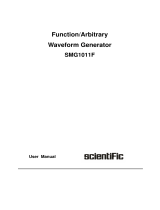
RIGOL
DG4000 Series User’s Guide
XI
DG4000 Series Overview
DG4000 is a dual-channel economical, high-performance and multifunctional
generator that combines many functions in one, including Function Generator,
Arbitrary Waveform Generator, Pulse Generator, Harmonics Generator,
Analog/Digital modulator and Counter. All the models of DG4000 provide two
channels with equivalent functions and adjustable phase between the two
channels.
Main Features:
Adopt the Direct Digital Synthesizer (DDS) technology and provide stable,
precise, pure and low distortion signals.
7 inches, 16M true color TFT LCD, displaying parameters and graphics of the
two channels at the same time.
160MHz, 100MHz or 60MHz maximum output frequency (for Sine), 500MSa/s
sample rate, 14bits vertical resolution.
Precisely adjust the phases of the two channels.
150 waveforms or functions: Sine, Square, Ramp, Pulse, Noise, Sinc,
Exponential Rise, Exponential Fall, ECG, Gauss, Haversine, Lorentz, Dual
Tones, Harmonics, Video Signal, Radar Signal, DC etc.
Enable to edit 16kpts arbitrary waveform and support point by point output of
arbitrary waveform.
Rise Time and Fall Time of the Pulse could be adjusted separately.
Enable to output harmonic with specified order and amplitude, enable to
output up to 16
th
order of harmonic.
Support to superpose Gauss Noise onto basic waveforms.
Various modulation types: AM, FM, PM, ASK, FSK, PSK, BPSK, QPSK, 3FSK,
4FSK, OSK and PWM modulations.
Support frequency sweep and Burst output.
Dual channels can perform internal/external modulation and
internal/external/manual trigger separately or at the same time.
Dual channels can output sync signal separately or at the same time.
Support to enable Frequency Coupling, Phase Coupling and Amplitude
Coupling separately or at the same time.
Provide 7digits/s, 200MHz counter; enable to measure various parameters of
external signal such as frequency, period, duty cycle, positive pulse width and
negative pulse width; provide statistic function of measurement results.
Support waveform copy and state copy between channels.
Enable to store and recall 10 arbitrary waveform data files and 10 instrument
























